The Science and Design of Dune’s Stillsuit
Summary
The stillsuit is a type of attire used by the inhabitants of the desert planet, Dun in the science fiction novel, Dune by Frank Herbert. The suits allow human beings to survive in the arid desert by recycling their bodily waste into drinking water. In the making of the new Dune movie, close to 200 suits were created, with inspiration drawn from medieval knights. The suits were custom made for each actor using molds of their body, and various layers of flexible material were used to ensure the actors’ comfort. While the concept of a stillsuit is science fiction, it draws parallels with water recycling technology used by NASA in space.
Table of Contents
- The Functioning of the Stillsuit
- Inspiration from Medieval Knights
- Prototyping and Design
- NASA’s Water Recycling Technology
- The Possibility of a Real Stillsuit
- Conclusion
The Functioning of the Stillsuit
The purpose of the stillsuit is simple: to allow human beings to survive in an arid desert by capturing their bodily fluid and recycling it to drinking water. The suit functions by using a high-efficiency filtration system that captures moisture and recycles it into drinking water. In the Dune universe, without the stillsuit, human beings cannot survive in the harsh climate. A functional stillsuit shouldn’t lose more than a thimbleful of water a day, ensuring the wearer has enough water to survive.
Inspiration from Medieval Knights
In designing the stillsuit for the new Dune movie, the design team sought to remain as faithful as possible to Frank Herbert’s original descriptions of the suit in the groundbreaking 1965 novel. To design the suit, they drew inspiration from medieval knights. The armor was designed to replicate the Templar armor, and each piece was designed to be flexible, much like a knights’ armor, providing ample movement for the actors in the harsh conditions of the desert.
Prototyping and Design
After the design team came up with the concept, they called upon an artist who had designed suits for the original Batman movie to build a prototype. Using flexible materials and molds of each actor’s body shape, the team built nearly 200 custom suits, ensuring the actors’ comfort even in the harsh desert conditions where temperatures could rise to over 100 degrees.
NASA’s Water Recycling Technology
NASA uses a water recycling system on the International Space Station that recycles urine, humidity, and sweat into drinking water. Crew members collect urine separately using a funnel-like structure, and it’s collected in tanks, where chemicals are added to prevent ammonia and other gases from forming. Additionally, the station removes humidity from the air using a water processor, which purifies the urine and humidity for consumption. About 50% of the crew member’s water comes from urine, and about 50% comes from perspiration.
The Possibility of a Real Stillsuit
Although stillsuits are still science fiction, the concept of energy conservation and recycling is timeless. Recycle human waste requires a lot of energy that is typically more than the human body can provide. While it may be possible to capture energy from body movement and recover water, it still requires a lot of work, and the body can only generate 25% efficient energy from the calories it consumes.
Conclusion
The production of the Dune movie was a remarkable feat in terms of costume design and world-building based on the novel’s description. The stillsuit’s invention could provide a concept of surviving in an entirely uninhabitable desert plane, which is characteristic of science fiction, where authors push the envelope about what is possible. While not entirely possible in reality, some parts of its design could be viable and useful in the future.






